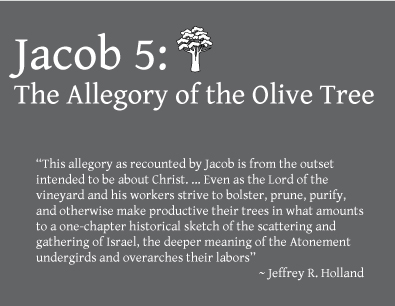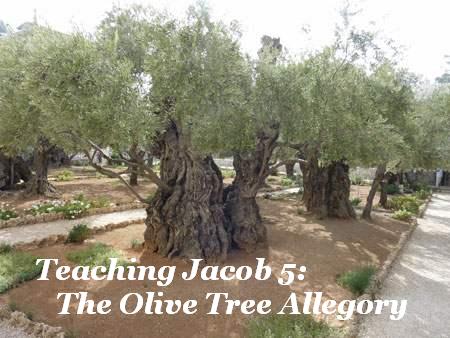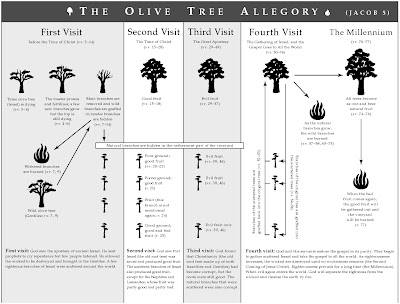Today I am home from church with a sick kid, so I thought I’d begin my collection of information on how to teach Jacob 5 next year. I am hoping to do it in two parts, with one an introductory section with explanations of the symbols and olive tree horticulture and a second one blowing through the history of the House of Israel. It is quite a feat to read all of Jacob 5 in one setting, but it really does make more sense in a single dose, I think. Hopefully my students can handle it. I’ll try to schedule that for a Monday.
Anyway, here is the beginning of the things I am finding online:
The Symbols
The Allegory of the Olive Tree by Ricks and Welch. This is a great text for understanding the symbols in the Olive Tree allegory, especially if you are unfamiliar with it. It brings up a few points that are interesting and that I would not have considered.
http://www.lds.org/manual/book-of-mormon-seminary-teacher-manual/jacob/lesson-46?lang=eng – Lesson 46 of the new Book of Mormon Seminary Teacher’s manual contains a link to a table of explanatory information on the olive tree allegory. I am surprised at how much crawfishing the new manual seems to do on the symbols and text. They seem so plain to me. If there is another explanation for the text I’d love to hear it, but it’s never addressed in the manual. Anyway. The lesson in the manual is confusing and nonlinear as far as I can see, and I’ll have to do a good bit of work to make it better. If you’re using the mobile site, you’ll have to look at the table in a pop up. Here it is :
JACOB 5: ALLEGORY OF THE TAME AND WILD OLIVE TREES
POSSIBLE MEANING
|
Tame olive tree |
The house of Israel, God’s covenant people |
|
The vineyard |
The world |
|
Decay |
Sin and apostasy |
|
Lord and master of the vineyard |
Jesus Christ |
|
Pruning, digging, and nourishing |
The Lord’s efforts to help people receive the blessings of His Atonement |
|
Servant of the master of the vineyard |
The Lord’s prophets |
|
Branches |
Groups of people |
|
Wild olive tree |
Gentiles—those who have not made covenants with the Lord. Later in the allegory, natural olive trees become wild, representing portions of the house of Israel that fall into apostasy. |
|
Grafting and planting branches |
The scattering and gathering of the Lord’s covenant people. In addition, the grafting of wild branches into the tame olive tree represents the conversion of thoere se who become part of the Lord’s covenant people. |
|
Burning branches |
God’s judgments on the wicked |
|
Fruit |
The lives or works of people |
Multimedia
http://www.churchofjesuschrist.org/media-library/video/book-of-mormon/jacob-mosiah?lang=eng#2012-08-1640-old-testament-olive-vineyard – There is a series of videos on the olive tree allegory at the link above. The final (fifth segment) movie in the series is unusable for the way I think I’ll be teaching. The other videos are slightly confusing, because the man in the vineyard doesn’t do a good job explaining that the allegory shows time passing, and so the people in the story are changing their dress according to the presumed timing of events in the allegory.You won’t be able to use these videos without significant explanation and commentary. For example, people are dressed in Renaissance attire for the apostasy when the trees are making bad fruit only. The videos are of decent quality however, and the segments are short enough to use in class. I think I’ll be using them during my summary lesson.
http://www.youtube.com/watch?v=Pq08CF2HAts – I’ve posted links to these great videos before. The man is speaking Greek, but you can turn on the subtitles and see the information in English. I used this with my class last year, but I may run it again. The kids actually liked it. This link is to the first video — it shows how violent grafting actually is. You basically shear off the entire branch system leaving just the roots and then put in a few tiny grafts. The guy in the church video does a very happy grafting that would result in branches that overpower the roots.
http://www.youtube.com/watch?v=IgAhM8ekmzA – This video is the Greek guy again showing what the olive trees look like after the grafts form. Eventually you can’t tell there was ever a graft.
Handouts
This handout is from the Principles of the Gospel blog entry on Jacob 5. This is my preferred handout since it’s a single page version of the Church’s handout, though I may end up making my own handout with branches the kids can move around.
– This handout is from the Gospel Principles and Studies blog. I think the final section is confusing, but overall it’s a good handout.
Jenny’s Jacob 5 Study Booklet

Check out the study booklet I made for Jacob 5 here:
Botany and Jacob 5
http://mimobile.byu.edu/?m=5&table=books&bookid=124&id=1485 – this is a collection of quotes related to the relevant botanical aspects.
Some points I think are relevant:
- Olive trees grown from seed bear fruit that is poor/wild. They require help, or grafting, to bear the best/tame fruit.
- Grafting is a violent process (see the Greek videos above), but it is necessary to keep olive trees producing as much good fruit as possible.
- Zenos probably knew a lot about olive trees — A LOT. The information in this chapter shows a familiarization with olive tree production. As far as I know, all of the techniques he describes are actual techniques used to save the roots of good/tame trees. He may have influenced Isaiah 6, too.
- The burning of an individual olive tree is done to prevent parasites and bacteria that may be present in the sick branches from infesting the rest of the grove. It also clears the ground, preventing weed growth and making it easier to care for healthy trees.
- Olive groves are sometimes burned deliberately to reconstitute them. When reconstituting an olive tree by burning, the tree is taken up, leaving only the large roots. After burning and cultivation it is possible to get from two hundred to three hundred trees per hectare in what was a grove with one hundred trees per hectare before it was burned. Thus, burning an olive grove is a symbol of rebirth. It conveys botanically the idea of starting over.
The title of this article is “” from the Maxwell Institute.
More information
BYU’s Neal A Maxwell Institute has an entire list of articles related to Jacob 5 here: http://mimobile.byu.edu/?m=5&table=books&bookid=124 . If you can’t find the answer to your questions in one of the articles here, it probably can’t be answered.



